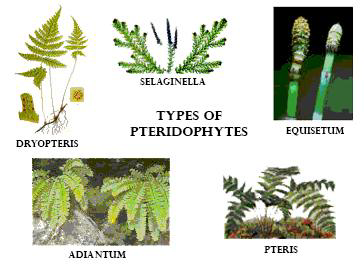
Enlist the general characters of pteridophytes with example.
Answer
505.5k+ views
Hint: A pteridophyte is a vascular plant (includes xylem and phloem) that scatter spores. Pteridophytes produce neither flowers nor seeds. They are sometimes mentioned as ‘Cryptogams’, which suggests that their means of reproduction are hidden. Ferns and lycophytes all are pteridophytes.
Complete answer:
The general characters of pteridophytes are –
-Pteridophytes are the first true land plants.
-They are seedless, and they procreate through spores.
-A pteridophyte is a vascular plant. The water and minerals flow from the surface of the plant- cell to cell in the plant’s body.
-The sporophyte generation and the gametophyte generation both are seen in Pteridophytes.
-Sporophyte has true roots, stem, and leaves as they contain vascular tissues.
-The sporangium is the structure in which spores are formed. They are usually homosporous (meaning: one sort of spore is produced) and also are heterosporous, (meaning: two sorts of spores are produced.)
-Sporangia are produced in groups on sporophylls:
-The tip of the leaves tends to curl inwards to protect the vulnerable growing parts.
-The male sex organs are called antheridia, while the female sex organs are called archegonia.
-They are found in cool, damp, shady places.
Examples of Pteridophyta are- Man fern, Silver fern, Whisk Fern, Flying Spider, Salvinia natans, Equisetum, selaginella, adiantum, etc.

Note: Life cycle of Pteridophytes is almost the same as seed-bearing plants, where alternation of generations is observed. However, pteridophytes don't possess seeds; instead, they use spores. Some groups of pteridophytes are at present extinct and known only from fossils.
Complete answer:
The general characters of pteridophytes are –
-Pteridophytes are the first true land plants.
-They are seedless, and they procreate through spores.
-A pteridophyte is a vascular plant. The water and minerals flow from the surface of the plant- cell to cell in the plant’s body.
-The sporophyte generation and the gametophyte generation both are seen in Pteridophytes.
-Sporophyte has true roots, stem, and leaves as they contain vascular tissues.
-The sporangium is the structure in which spores are formed. They are usually homosporous (meaning: one sort of spore is produced) and also are heterosporous, (meaning: two sorts of spores are produced.)
-Sporangia are produced in groups on sporophylls:
-The tip of the leaves tends to curl inwards to protect the vulnerable growing parts.
-The male sex organs are called antheridia, while the female sex organs are called archegonia.
-They are found in cool, damp, shady places.
Examples of Pteridophyta are- Man fern, Silver fern, Whisk Fern, Flying Spider, Salvinia natans, Equisetum, selaginella, adiantum, etc.

Note: Life cycle of Pteridophytes is almost the same as seed-bearing plants, where alternation of generations is observed. However, pteridophytes don't possess seeds; instead, they use spores. Some groups of pteridophytes are at present extinct and known only from fossils.
Latest Vedantu courses for you
Grade 11 Science PCM | CBSE | SCHOOL | English
CBSE (2025-26)
School Full course for CBSE students
₹41,848 per year
EMI starts from ₹3,487.34 per month
Recently Updated Pages
Master Class 11 Economics: Engaging Questions & Answers for Success

Master Class 11 Business Studies: Engaging Questions & Answers for Success

Master Class 11 Accountancy: Engaging Questions & Answers for Success

Master Class 11 English: Engaging Questions & Answers for Success

Master Class 11 Computer Science: Engaging Questions & Answers for Success

Master Class 11 Maths: Engaging Questions & Answers for Success

Trending doubts
State and prove Bernoullis theorem class 11 physics CBSE

1 ton equals to A 100 kg B 1000 kg C 10 kg D 10000 class 11 physics CBSE

State the laws of reflection of light

One Metric ton is equal to kg A 10000 B 1000 C 100 class 11 physics CBSE

1 Quintal is equal to a 110 kg b 10 kg c 100kg d 1000 class 11 physics CBSE

Difference Between Prokaryotic Cells and Eukaryotic Cells




